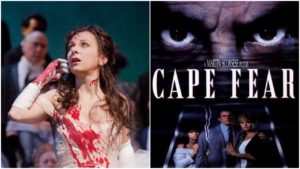
Opera Meets Film: How a Choral Passage from ‘Lucia di Lammermoor’ Emphasizes Robert DeNiro’s Operatic Turn in ‘Cape Fear’
By David Salazar“Opera Meets Film” is a feature dedicated to exploring the way that opera has been employed in cinema. We will select a film section or a film in its entirety and highlight the impact that utilizing the operatic form or sections from an opera can alter our perception of a film that we are viewing. This week’s installment features Martin Scorcese’s “Cape Fear.”
Scorcese is one of the great operatic film directors. His movies, burgeoning with some of the most iconic characters in cinema history, are full of intense expressionist approaches to style and editing. Whether it be how he employs the camera, how music structures a setpiece, or the often larger-than-life performances he draws from actors, few directors manage that all-encompassing approach to cinema that rivals opera.
“Cape Fear” does not immediately strike you as a Scorcese film. On one hand, that’s the result of him taking over the project from Steven Spielberg. Part of it is the fact that it is a remake of a previous 1962 film. But ultimately, it’s also the result of Scorcese embracing his inner Hitchcock to create a work that feels like it was made by the master of suspense himself.
But one element does stick out from within this elaborate stylistic web as a Scorcese trademark – Roberto DeNiro’s operatic performance.
DeNiro’s Max Cady dominates the film like nothing else. He has to. Even when he’s not onscreen, the threat of Cady lurking around every corner is essential to maintain the suspense throughout the picture. So to achieve that effect, Scorcese needed DeNiro to fill up the frame every time he was in front of it.
From the tattoo overload on his body to the intense glare he throws in Nick Nolte’s direction at every turn, to the increasingly vocal and physical histrionics as the story exposes his obsessive madness, this is a performance brimming with bravado.
So it’s not surprising that Scorcese would underpin it at some point with an excerpt from an opera iconic for its depiction of madness – “Lucia di Lammermoor.” As DeNiro’s Max Cady chases after the Bowden family on their way to an airport, he flips on the radio, eventually landing on a recording of “Per te d’immenso giubilo.”
This chorus precedes the wedding feast for Lucia and Arturo. And while the ensemble sings of joy and festivity, Lucia is about to enter into her lowest point – a forced marriage she wants nothing to do with. It’s the ultimate imprisonment for her. Throughout the rest of the opera, the heroine, finding herself increasingly cornered by the rigid social system around her, lashes out by murdering her husband before descending into intense madness and subsequent death.
Max Cady, DeNiro’s character, goes through a similar transformation. As “white trash (as he is often referred to),” he was once a victim of a system that took advantage of illiterate men like him. And the ultimate sentence of 14 years in prison ultimately drove him to a mad obsession with vengeance.
So he turns the tables. He finds a way to become the system and drive the Bowdens insane through paranoia. Where he was once Lucia, stripped of his freedom by Bowden’s corruption, now he’s turned the Bowdens into Lucia’s stand-in while he perpetuates his own cruel justice and corruption.
The chorus reflects his state of mind at this moment, full of jubilation as he literally makes Bowden flee from the town due to his own scheming. It’s a seeming victory for him. And while the brief passage is a bit stylistically inconsistent with the rest of the film (Scorcese employs the score by Bernard Hermann from the 1962 film throughout), it drives home the idea of Cady as an operatic being. A larger-than-life figure consuming centerstage, the performance increasingly ratcheted by DeNiro until it reaches feral limits in its final 20 minutes.
Categories
Opera Meets Film

